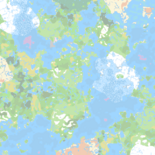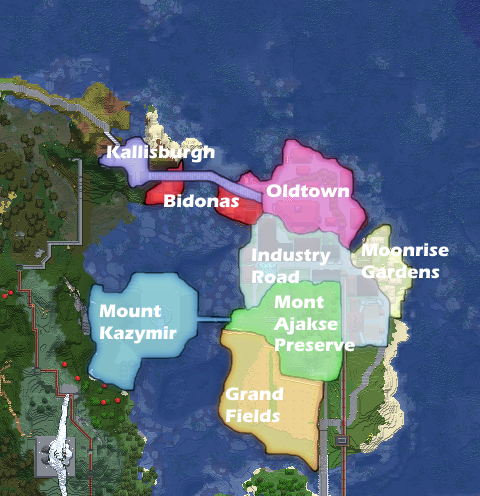Kaljista
| Kaljista | ||
|---|---|---|
| Major City | ||
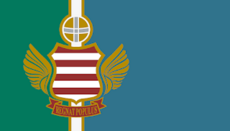 Flag of Kaljista (Flag of Danúvia) Flag of Kaljista (Flag of Danúvia)
| ||

In-game Banner of Kaljista (Banner of Danúvia) | ||
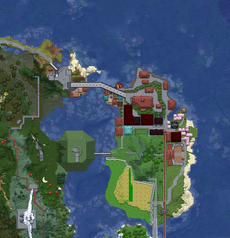 Map of Kaljista and Surroundings 29/01/2025 Map of Kaljista and Surroundings 29/01/2025
| ||
| Overview | ||
| Player Population | ZarKolja | |
| Demonym | Kaljistan | |
| Divisions | 7 | |
| e | ||
| Location | East-central Cinder; the Sanéan Ocean
| |
| Country | Diryn Imperium | |
| Region | Danúvia | |
| e | ||
| Mayor | Hermann Ailbos
Nykol Haartmann (former) Miklos Némann (former) | |
| Legislation | Kaljista City Council | |
| e | ||
| Date of Foundation (IRL) | September 1st, 2023 | |
| Date of Foundation (RP) | TBA | |
Kaljista is a danúvian city situated on the island of Kórsia. The City is one of the oldest settlements in the South of the continent, having been founded on the 1st of September 2023. Since the fall of Danúvia, it gradually became the central metropolitan area of the region, replacing Ístropolj as regional capital in the nations of Messenia, Sanéa and the Diryn Imperium.
Being the city from which the Messenian Metro started operating and expanding their vast tunnel system from, Kaljista is generally known as the Railway Capital.
History
Danúvian Era
Kaljista's origins lie in the first wave of expansion of the Duchy of Istropolj which would later be known as Grand Duchy of Danúvia.
Settlers of Ister ethnicity would settle down in the most northern tip of the Island of Kórsia, giving their new home the name "Ajakse". Their settlement would primarily consist of elegant Ister wooden pillar houses on a solid stone base. The biggest of them, which is located on top of a larger hill, would soon become to be known as Tollhouse, as it was the base of operations for Danuvian tax collectors, also taxing maritime trade.
With the second wave of settlers arriving, Ajakse would receive a large amount of Ailb people to work the fields and primitive farms. They would take shelter in small primitive wooden houses which are today known as the Kaljistan slums. The Ailbs would give the place another name: Kaljista. And with the Ister part of the population dwindling and said ethnicity soon only be existing within the upper class, the old name of Ajakse would soon be swept away. "Kaljista" would finally be recognized as official settlement name by the Ducal office in Istropolj, when the settlement finally reached city status.
By then, the Tollhouse had been refitted into a townhall with the first mayor of Kaljista also being of the Ailb ethnicity.
The island of Kórsia was then organized into its own province, with its lands, now also consisting of the largest granary of Danúvia, governed from Kaljista. Said time would be the start of the Age of prosperity for Kaljista, with industrialization setting in along with the addition of proper Ailb style brick buildings and a massive Blackstone bridge, leading up to a mountain on the other side of the Korsian Bay, which is now a key component in the connecting of the Southern and Northern road networks.
Kaljista also became the seat of the Dual Church o Egjenism, with its first mayor Miklos Némann taking up the role of Équator, the faith's religious leader. Across Danúvia, Kaljista had generally been referred to as Scetét's city, giving birth to name inspirations such as the name of Kaljista's tavern: Scetét's Jest.
During the Age of Crisis and the fall of Danúvia, the last royalist remnant would have its base in Kaljista from where it would strike at revolutionary Republicans down south in the capital of Ístropolj. After crushing the last rebels, the Danúvian spirit was already fully dead, with its most southern cities handed over to Dirynum and many people fleeing the region.
Kaljista would undergo a short period of independence as Kórsian State before entering negotiations with the neighboring city state of Alaetia. (Modern-day Ephesus)
The negotiations would result in the establishment of the Principate of Messenia, which Kórsia, as its own province, became a part of. Through Kórsia, Messenia was also considered the rightful successor of Danúvia.
The New shift from the south towards the more northern Alaetia would see the rapid improvement of infrastructure such as the first metro line of the Messenian Metro between Alaetia and Kaljista as well as fortified borders along the road between the two cities to solidify control and guard the road against bordering Kothmire.
Sanéan Era
TBD
Administration
Kaljista is administrated by a Major and his cabinet, along with a autocratic City Council acting as legislative body. The council and the Mayor's cabinent both convene regularily in the Tollhouse to debate and decide on policies of any kind.
Subdivisions
Kaljista can be divided into 7 general districts: the Oltown with the Tollhouse at its centre, the Kallisburgh guarding the western entrance and the bridge, the Gardens of Moonrise, harboring the Gyha and the Haartmann Mausoleum, the Bidona slums on both sides of the Kórsian bay, the industrial centre of Industry road and Mount Kazymir, a natural fortress to assert effective control over the Kórsian Bay and the Grand Fields, an area taking up roughly a sixth of the island of Kórsia, supplying Kaljista's population with fresh crops. In between the Grand fields and Industry Road lies the natural preserve of Mont Ajakse.
Map of Kaljista's subdivisions, 29/01/2025
Demographics
Ethnicities
The bulk of Kaljista’s Population (roughly 54%) is considered Danúvian of either Íster or Ailb origin, with the ancestors of the Danúvian inhabitants mainly having arrived during the first and second expansion wave of the Duchy of Istropolj as well as the fall of Old Danúvia. The latest wave of Danúvian immigration took place during the Mustyrian War, with many fleeing from the Chaos in the North.
At the same time, a number of Ephesinians and Mustyrians also settled on Korsia for similar reasons, nowadays equating to just short of 8% and 6% of the population respectively.
During the Sanéan era and the elevation of Kaljista to the capital of the Region, the city experienced a steady influx of Diryn merchants and settlers. The number of Diryn inhabitants was further inflated by the fall of Ashannar, with them now making up ⅕ of the Population.
The Introduction of the Diryn Imperium lured the Ashannari into the City, guided by his Radiance the Imperator Sol Aureus I. with every 1 in 8 people considered of Ashannari origin nowadays.
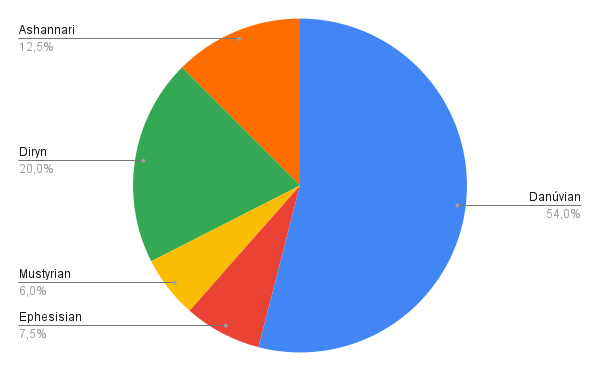
Data taken from Census on January 10th 2025
Religion
Historically, Kaljista had been the seat of the Egjenist Dual Church, a local Danúvian dualist faith. After Nykol Hartmann’s religious reformation, the whole of Danúvia became part of the international Moonrisen community within the enlightened Scetétian Church of Moonrise. At the moment 41% of Kaljista believes in Moonrisen teachings.
The other religions present had all been imported by citizens foreign to the area. Pyrannism first reached Kaljista during its time in Messenia and then during the Mustyrian war, with every 1 in 12 Kaljistans being a Pyrannist nowadays.
The largest religious group in Kaljista are the Solists. Already spreading to Kaljista in the Sanéan era, the formerly moonrisen dominated City became Solist by majority after the fall of Ashannar, which also saw part of the danúvian political elite convert to Solism to please the Imperator. The number of Solists in Kaljista amounts to roughly 51 per cent of the population, with all 3 largest ethnicities almost dominated by Solism.
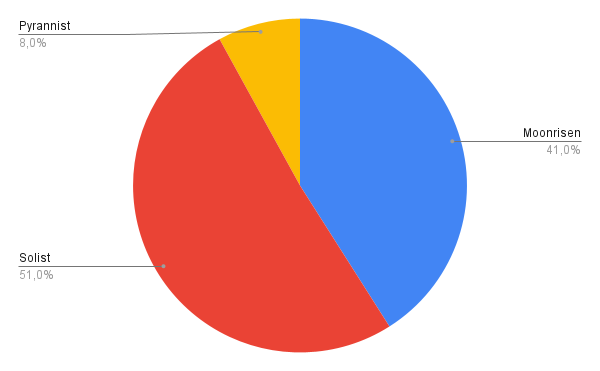
Data taken from Census on January 10th 2025
Society
During the times of old Danúvia, the Ailbs had originally been the poor working class, living in the Kaljistan slums, while the Ísters acted as rulers and administrators. This imbalance shifted over time however, with the Ailbs ascending to become the City’s middle class, while the cultural fusion of Ailbs and Ísters continued to solidify.
In our times, the majority of upper class citizens are ethnic Danúvians of either faith, living in the oldest part of Kaljista and serving as members of the City Watch, Industrialists or as Administrators in the City Council. Furthermore, a new kind of Solist Elite has been settling on Korsia, exerting their influence by being overrepresented in the City Council, enjoying the backing of the Imperator.
The City’s lower class is primarily dominated by the Solist Ashannari, Moonrisen Danúvians and Pyrannists who mainly live in the poorest districts under the Grand Bridge. However, some Ashannari have ascended to upper ranks in Kaljista’s society by undergoing military careers in the City Watch. Furthermore the Ashannari, in response to the housing crisis that had been sparked by the waves of refugees, had gone ahead and constructed their own district on the other side of the Korsian Bay. The lower class, largest in numbers. represents the industrial backbone of the city, working day and night in Kaljista’s vast industrial complexes.
Kaljista's middle class is made up of Diryn and Danúvian merchants, bureaucrats, priests and foremen with numbers almost evenly split between Solists and Moonrisen.
All in all, Faith and wealth dictate the city’s political and social landscape the most, with people of the same faith or social class banding together over issues in different combinations, resulting in interesting dynamics and shifting balances of power.
Military
Since the fall of Danúvia, Kaljista has had a permanently standing military force, the Kaljista City Watch. First formed from danúvian kazymirist army remnants, it exercises military control over Kórsia and Ístropolj.
Its base of operations are the Kaljista Barracks, the Undercity, Kallisburgh, Mount Kazymir and the Mapping Guild in Ístropolj. The Kaljista City Watch has partaken in a number of prestigious military operations, such as the Liberation o Ístropolj, the capturing of Spurius Aemilianus and Nykol Haartmann's last stand against Sol Aureus.
Nowadays, the City Watch offers a lucrative carreer for many Kaljistans who want to climb the social ladder and earn a name for themselves.
